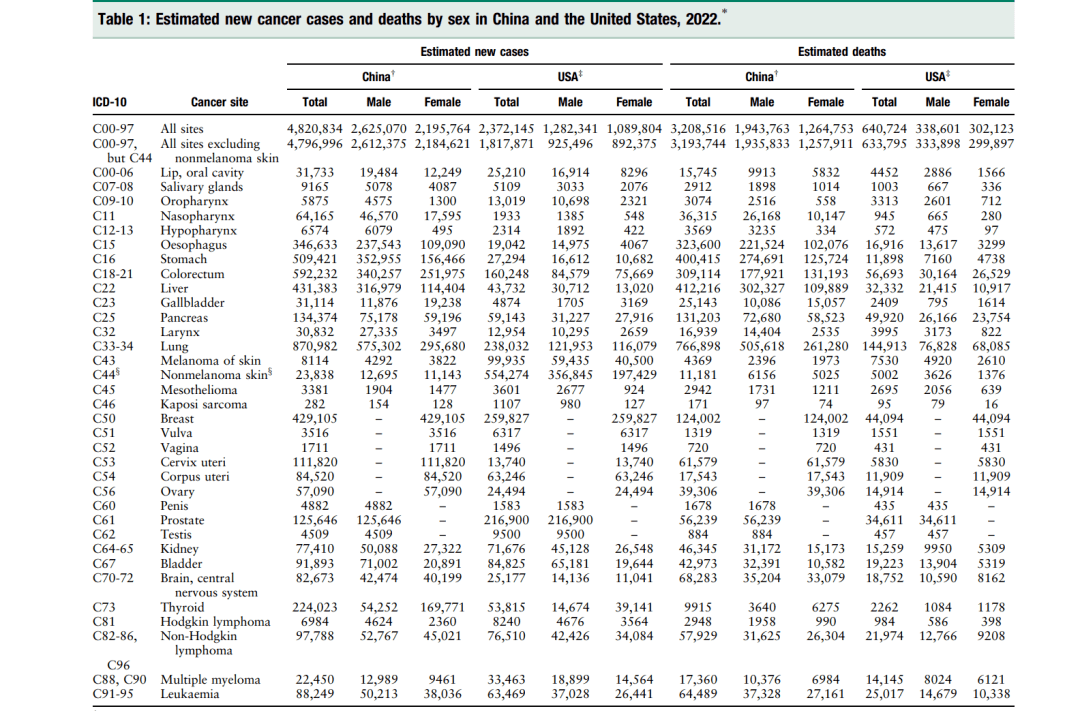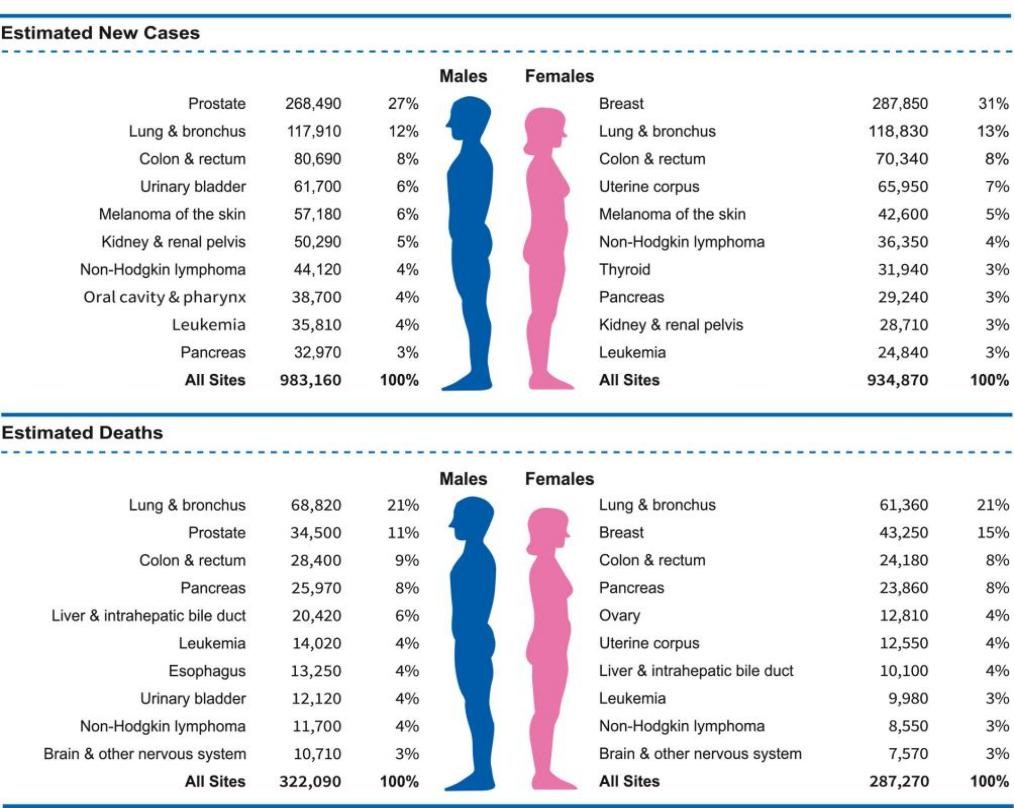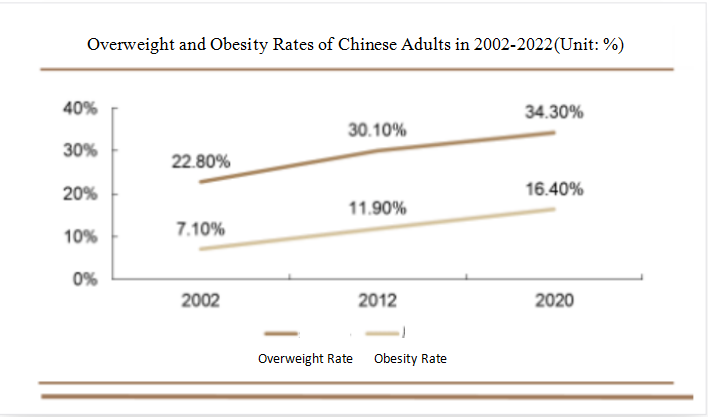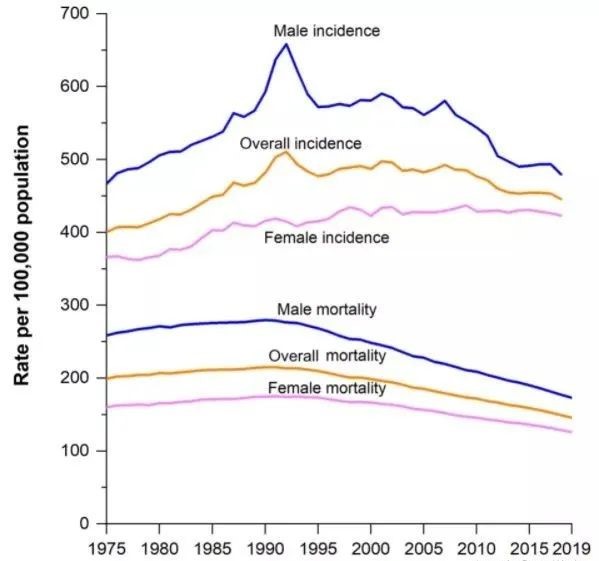-
News & Events

With the increasing incidence rate of cancer, people are not strangers to various cancers any more. Cancer will bring about increasingly huge economic burdens for a family and a country alike when it progresses.
Despite the fact that the incidence and mortality rates of different cancers vary from developed countries to developing ones, the high incidence rate of cancers is generally closely related to the fast population growth, the increasing aging problem and the prevalence of cancer related risk factors.
Cancer Statistics, 2022 published on CA: A Cancer Journal For Clinicians summarizes and analyzes the new cases, deaths, morbidity trends and survival rate of various cancers in the US. These statistics clearly show the current situation and future development trends of cancers in the US, and help us understand and prevent cancers and with the national policy-making.
At the same time, Professor Chen Wanqing and his team members of National Cancer Center, Chinese Academy of Medical Sciences and Peking Union Medical College Hospital, published a paper on Chinese Medical Journal, studying and comparing the current situation of cancers in China and the US.
New Cancer Incidence and Mortality Rates: China vs US
According to the Statistics and the paper, in 2022, there will be approximately 4.82 million and 2.37 million new cancer cases, and 3.21 million and 640,000 cancer deaths in China and the US, respectively.
In other words, China’s new cancer cases and deaths will be about twice and five times those of the US respectively.

Statistics show that there will be approximately 5,000 new cases each day in the US. Prostate, lung and bronchus (lung hereafter), and colorectal cancers (CRC) account for almost one-half (48%) of all incident cases in men. For women, breast cancer, lung cancer, and CRC account for 51% of all new diagnoses
An estimated 609,360 people in the United States will die from cancer in 2022, corresponding to almost 1700 deaths per day The greatest number of deaths are from cancers of the lung, prostate, and colorectum in men and of the lung, breast, and colorectum in women.

Lung Cancer, the Leading Cause of Cancer Death
Overall, lung cancer and CRC are still of a high incidence rate and mortality rate for the whole population, requiring strengthened prevention and treatment. With the highest mortality rates, lung cancer will become the most common cause of cancer death.
Lung cancer is also the leading cause of cancer death in China. According to the statistics in 2015, the incidence rate of lung cancer was the highest in men, and the second highest in women, and its mortality rate ranked the first in both.
Tips:
High risk groups of lung cancer include:
1. People with a family history of lung cancer;
2. Those who have a history of lung diseases, and those whose basic lung diseases have not been cured;
3. Long term and heavy smokers; and
4. Those who are often exposed to asbestos, tar, chromium and other harmful substances.
Death Rate of Lung Cancer Declined with Less Smokers
Tobacco has become popular since the 20th century, leading to a sharp rise in lung cancer mortality rate. However, with the decrease of smokers and the technological progress of early diagnosis and treatment of lung cancer, the mortality rate of lung cancer began to show a downward trend.
The Statistics shows that the incidence rate of lung cancer in the US declined from 2009 to 2018 by almost 3% annually in men and 1% annually in women. Declines have been slower in women than in men because women took up cigarette smoking in large numbers later and were slower to quit. As a result, the sex gap in lung cancer incidence has narrowed by 12% in men and 13% in women.
Cigarette smoking is the most common risk factor for lung cancer. In the US, 81% of men and 72% of women aged 20 to 49 years recently diagnosed with lung cancer had smoked. Chinese adults also have a high smoking prevalence (25.2% in 2013) and approximately 16.8% of all cancer deaths in adults 30 years and older in China were attributable to active and second-hand smoking, and more than 98% of these deaths in men were attributable to active smoking compared with 50% in women.
Therefore, taking active tobacco control actions, smoking less and urging the whole society to quit smoking can reduce the probability of lung cancer and even death caused by smoking.
Tips:
Causes of lung cancer
The causes of lung cancer are not completely clear. But the main risk factors are smoking, genetics, air pollution, occupational exposure, ionizing radiation, history of lung diseases.
1. Smoking. Tobacco smoking is by far the main contributor to lung cancer. The risk of lung cancer and the mortality rate in smokers is 20 times and 4 to 10 times those of non-smokers, respectively. And they are closely connected to when smokers start smoking, and how long and how many cigarettes have they smoked.
2. Genetics. Researches have found familial aggregation in the occurrence of lung cancer, which, therefore, is possible to be related to genetic susceptibility and genes.
3. Air pollution. In recent years, it has been found that air pollution caused by indoor cooking is closely connected to the occurrence of female lung cancer. In addition, outdoor air pollution such as industrial exhaust and automobile exhaust is also one of the risk factors of lung cancer.
4. Occupational exposure. Some occupations may require exposure to dangerous carcinogens such as asbestos, tar and formaldehyde, thus causing lung cancer.
5. Lung diseases. Patients who have not been cured of pulmonary tuberculosis, chronic obstructive pulmonary disease and other lung diseases face higher risks of developing lung cancer.
6. Others. Ionizing radiation, diet and nutrition, virus infection (such as HIV, EB virus) and other factors are also associated with the occurrence of lung cancer.
Breast Cancer Will Become the Most Common Cancer
With 287,850 expected new cases of breast cancer in the Statistics, breast cancer will cause the most cases among other cancers in the US.
Global Cancer Statistics 2020 powered by the International Agency for Research on Cancer (IARC) of World Health Organization estimates the incidence and mortality rates of cancer in countries. Among them, the new cases of breast cancer in the world are as high as 2.26 million, exceeding the 2.2 million cases of lung cancer. Breast cancer will become the most common cancer worldwide with more than half of cases in developing countries.
Multiple factors contribute to the increase of the incidence rate of breast cancer. The leading cause is the development of breast cancer screening technology and the promotion of early screening for breast cancer followed by the decline of fertility rate and the rising proportion of overweight and obesity. And the increase of breast cancer incidence caused by the decline of fertility rate and the rising proportion of overweight and obesity may be related to the increase of exposure time of estrogen.
Early screening of breast cancer is of great benefit to reducing the incidence and mortality rates of breast cancer. A mammogram is recommended at least once a year for women above the age of 40 while the high-risk population of breast cancer should do early screening under the age of 40.
Tips:
Breast Cancer Screening
1. A mammogram once a year is recommended for women aged 40-70 years. If the result indicates a type C or D breast gland, B-ultrasound examination is in need.
2. A mammogram once or twice a year is recommended for women above the age of 70;
3. High risk population of breast cancer (early screening age < 40 years old) are recommended to do a mammogram once a year and breast ultrasound examination every 6 to 12 months, and an additional breast enhanced MRI examination once a year if necessary.
Obesity or Induced Cancers
The gradually westernized diet (a high proportion of meat in the diet) and unhealthy dietary patterns (too much frying and grilling food) also increase the proportion of digestive tract related cancers. According to Report on Chinese Residents’ Chronic Diseases and Nutrition 2020, the overweight rate and obesity rate of adult residents (≥ 18 years old) in China are 34.3% and 16.4% respectively. In other words, more than half of Chinese adults are overweight or obese. Obesity can induce a variety of diseases, including diabetes, cardiovascular diseases, metabolic syndromes, and even cancers.
Overweight and Obesity Rates of Chinese Adults in 2002-2022(Unit: %)

Cancers’ Harm to Children and Adolescents is Noticeable
Leukemia Remains the Most Common Childhood Cancer
The most noticeable among the statistics are those of childhood and adolescent cancers. Cancer is the second most common cause of death among children aged 1 to 14 years in the US, and is the fourth most common cause of death among adolescents (aged 15-19 years). In 2022, approximately 15,950 children and adolescents (aged 15-19 years) will be diagnosed with cancer and 1,600 will die from the disease.
Leukemia is still the most common childhood cancer, accounting for 28% of cases, followed by brain and other nervous system tumors (26%). Cancer types and their distribution differ in adolescents; for example, brain and other nervous system tumors, more than one-half of which are benign or borderline malignant, are most common (21%), followed closely by lymphoma (19%).
The overall cancer incidence rate in children and adolescents has been increasing slightly. In contrast, death rates declined continuously for overall reductions of 71% in children and 61% in adolescents.
Population Aging is a Pathogenic Factor
China’s cancer profile is becoming similar to that of the USA and one of main factors is the arrival of the population aging.
China is one of the countries with the fastest growth rate of population aging in the world. The main data of the seventh national census show that in China the population aged 60 and over is 264 million, accounting for 18.7%; the population aged 65 and over is 190 million, or 13.5%. For most cancers, age is not only an important pathogenic factor but also an uncontrollable one in the occurrence and development of cancers.
Therefore, the incidence rate and mortality rate of cancers are also increasing greatly as the population aging is growing.
In addition to the population aging, there are controllable factors in causing cancers. They are also cancer-related risks, such as smoking, diet and environmental factors.

Overall Cancer Incidence and Mortality Rates Show Declining Trends
Overall cancer incidence in men generally decreased from the early 1990s until around 2013, the spike in incidence for males during the early 1990s reflects a surge in the detection of asymptomatic prostate cancer as a result of widespread rapid uptake of prostate-specific antigen (PSA) testing among previously unscreened men.
Generally speaking, the cancer incidence in men started to be stabilized through 2018; whereas in women, the rate was fairly stable through the mid-2010s but has ticked up slightly (0.2% per year) in recent data years. Consequently, the sex gap is slowly narrowing, with the male-to-female incidence rate ratio declining from 1.39 in 1995 to 1.14 in 2018.

The Statistics points out overall mortality trends in the US, which are largely driven by lung cancer followed by CRC. The lung cancer death rate has dropped by 56% from 1990 to 2019 in men and by 32% from 2002 to 2019 in women. Long-term reductions in mortality for CRC also contribute to overall progress, with rates dropping by 55% among males since 1978 and by 60% among females since 1969.
Of course, the most critical reason for the decline of total mortality is the progress of treatment technology, which can be seen in the total mortality of lung cancer. And the mortality rate of melanoma shows the largest reduction due to advances in treatment technology.
From 2013 to 2017, the mortality rate of melanoma patients aged 20 to 64 years decreased by 7% per year, and that of patients over 65 decreased by 5% to 6% mainly thanks to FDA’s approval of the use of Yervoy and Vemurafenib as immunotherapy for melanoma patients. Targeted drug therapy accelerated the decline not only of total mortality of lung cancer but of total mortality of chronic myeloid leukemia and lymphoma.
Cancer is Preventable and Controllable
Although dreadful, cancer is preventable and controllable. China is gradually implementing targeted policies and schemes to control the occurrence and development of cancers, such as advocating quitting smoking and encouraging school-age women to be vaccinated with HPV vaccines. For individuals, effective ways to prevent cancer include getting rid of an unhealthy diet and lifestyle, maintaining normal weight, having regular physical examinations and seeing a doctor if need be.
